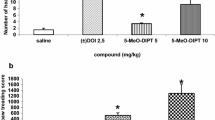Abstract
Effects of 1-methyl-4-phenyl-1,2,3,6-tetrahydropyridine (MPTP) and 5,7-dihydroxytryptamine (5,7-DHT) on striatal levels of dopamine (DA), 5-hydroxytryptamine (5-HT), and their metabolites, as well as on locomotor activity were investigated in C57BL/6 mice. The results showed that MPTP significantly increased locomotor activity and decreased striatal DA levels. However, injection of the serotonergic neurotoxin 5,7-DHT in the striatum, either alone or following high doses of MPTP, significantly decreased locomotor activity, and concomitantly decreased striatal levels of 5-HT and 5-HIAA. This study suggests that the increased locomotor activity may be due to increased striatal serotonergic activity which overcompensates for the DA deficiency. The locomotor hypoactivity, induced by 5,7-DHT, might be due to the decreased striatal levels of 5-HT and 5-HIAA.
Similar content being viewed by others
REFERENCES
Chia, L. G., Ni, D. R., Cheng, L. J., Kuo, J. S., Cheng, F. C., and Dryhurst, G. 1996. Effects of 1-methyl-4-phenyl-1,2,3,6-tetrahydropyridine and 5,7-dihydroxytryptamine on the locomotor activity and striatal amines in C57BL/6 mice, Neurosci. Let. 218:67–71.
Colotla, V. A., Flores, E., Oscos, A., Meueses, A., and Tapia, R. 1990. Effects of MPTP on locomotor activity in mice. Neurotoxicol Teratol. 12:405–407.
Kordower, J. H., Felten, S. Y., Felten, D. L., and Gash, D. M. 1986. Behavioral sequelae following MPTP administration in mice. Pages 413–417, in: Markey, S. P., Castagnoli, N. J., Trevor, A. J., and Kopin, I. J. (eds), MPTP: A Neurotoxin Producing a Parkinsonian Syndrome. Oriando: Academic Press.
Grahame-Smith, D. G. 1971. Studies in vivo on the relationship between brain tryptophan, brain 5-HT synthesis and hyperactivity in rats treated with a monoamine oxidase inhibitor and L-tryptophan. J Neurochem. 18:1053–1066.
Modigh, K. 1972. Central and peripheral effects of 5-hydroxytryptophan on motor activity in mice. Psychopharmacol. 23:48–54.
Mitra, N., Mohanakumar, K. P., and Ganguly, D. K. 1992. Dissociation of serotoninergic and dopaminergic componenets in acute effects of 1-methyl-4-phenyl-1,2,3,6-tetrahydropyridine in mice. Brain Res Bull 28:355–364.
Euvrard, C., and Boissier, J. R. 1980. Biochemical assessment of the central 5-HT agonist activity of RU 24969 (a piperidinyl indole). Eur. J. Pharmacol. 63:65–72.
Tricklebank, M. D, Forler, C., and Fozard, J. R. 1985. The involvement of subtypes of the 5-HT1 receptor and of catecholaminergic systems in the behavioural response to 8-hydroxy-2-(di-n-propylamino) tetralin in the rat. Eur J Pharmacol. 106:271–282.
Rempel, N. L., Callaway, C. W., and Geyer, M. A. 1993. Serotonin 1B receptor activation mimics behavioral effects of presynaptic serotonin release. Neuropsychopharmacol. 8(3):201–211.
Jacoby, J. H., Lytle, L. D., and Nelson, M. F. 1974. Long-term effects of 5,7-DHT on brain monoamines. Life Sci. 14:909–919.
Massotti, M., Scotti De Carolis, A., and Longo, V. G. 1974. Effects of three dihydroxylated derivatives of tryptamine on the behavior and on brain amine content in mice. Pharmacology Biochemistry and Behavior. 2:769–775.
Toyoshi, T., Ukiai, M., and Kameyama, T. 1995. Intrastriatal injection of opioid receptor agonists inhibits apomorphine-induced behavior in 6-hydroxydopamine-treated mice. Eur J Pharmacol. 294:637–643.
Chia, L. G., Liu, S. P., and Lee, E. H. Y. 1992. Differential effects of deprenyl and MPTP on catecholamines and activity in BALB/C mice. NeuroReport. 3:777–780.
Hu, S. C., Chang, F. W., Sung, Y. J., Hsu, W. M., and Lee, E. H. Y. 1991. Neurotoxic effects of 1-methyl-4-phenyl-1,2,3,6-tetrahydropyridine in the substantia nigra and the locus coeruleus in BALB/C mice. J Pharm Exp Therap. 259:1379–1387.
Cheng, F. C., Kuo, J. S., Shih, Y., Lai, J. S., Ni, D. R., and Chia, L. G. 1993. Simultaneous measurement of serotonin, catecholamines and their metabolites in mouse brain homogenates by high-performance liquid chromatography with a microbore column and dual electrochemical detection. J Chromatogr. 615:225–236.
Boschert, U., Amara, D. A., Segu, L., and Hen, R. 1994. The mouse 5-hydroxytryptamine 1B receptor is localized predominantly on axon terminals. Neurosci. 58(1):167–182.
Ueda, S., and Kawata, M. 1994. Regeneration of serotonergic immunoreactive fibers in the brain of 5,6-dihydroxytryptamine treated rat. J Himforsch. 35(1):159–180.
Author information
Authors and Affiliations
Rights and permissions
About this article
Cite this article
Chia, LG., Ni, DR., Cheng, FC. et al. Intrastriatal Injection of 5,7-Dihydroxytryptamine Decreased 5-HT Levels in the Striatum and Suppressed Locomotor Activity in C57BL/6 Mice. Neurochem Res 24, 719–722 (1999). https://doi.org/10.1023/A:1020771211305
Issue Date:
DOI: https://doi.org/10.1023/A:1020771211305



